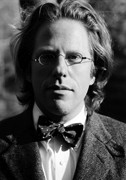The Art of Jonathon Keats

Jonathon Keats
But Keats has been active since then. He's got a new installation titled "Cloning Celebrity" at San Francisco's Modernism Gallery. Here's a description:
In five pilot studies at the AC Institute, Keats is epigenetically cloning five celebrities. His subjects are some of the most popular people alive, and some of the most widely emulated, including Lady Gaga, Michael Phelps and Barack Obama. He has metabolically analyzed each by assessing their gross biochemical intake, and is methodically exposing large populations of living cells to similar chemical formulae, systematically activating epigenetic mechanisms such as DNA methylation. While the cells are not human, they are known to be genetically similar to Homo sapiens, and have been used as model organisms in the world's leading laboratories. Keats is epigenetically cloning Obama, Phelps and Gaga in Saccharomyces cerevisiae, commonly known as brewer's yeast.

Dan Schifrin, writing in jweekly.com, describes some of Keats's other projects:
Keats made his debut in 2000 at Refusalon in San Francisco, where he sat in a chair and thought for 24 hours, with a female model posing nude in the gallery. His thoughts were sold to patrons as art, at a price determined by dividing their annual income down to the minute...
In 2004, in collaboration with U.C. Berkeley geneticists, Keats attempted to genetically engineer God in a laboratory. Keats determined that God bore a striking genetic similarity to algae, but — employing proper scientific language — he acknowledged that the study was "not definitive."...
He also was commissioned by the Contemporary Jewish Museum to make a modern version of manna, which he interpreted as a pillbox full of placebos — manna being whatever medicine was needed at that moment.
In 2004, in collaboration with U.C. Berkeley geneticists, Keats attempted to genetically engineer God in a laboratory. Keats determined that God bore a striking genetic similarity to algae, but — employing proper scientific language — he acknowledged that the study was "not definitive."...
He also was commissioned by the Contemporary Jewish Museum to make a modern version of manna, which he interpreted as a pillbox full of placebos — manna being whatever medicine was needed at that moment.
Comments
Yep, he's a loony, but one with a very active imagination!
I guess you could call him the MacGyver of Madness...
I guess you could call him the MacGyver of Madness...
Posted by Captain DaFt on 09/24/12 at 12:48 AM
If he sells his "art" for the buyer's worth in a minute I'd say he's just about on target with me. (Just over a mill and a half.)
Posted by Expat47 in Athens, Greece on 09/24/12 at 01:50 AM
Radical thinkers are loons to those who don't understand them. Either way he appears to be making a living out of it.
Posted by dumbledoor on 09/24/12 at 04:30 AM
At least it appears he hasn't worked with poo or vomit. He seems like such a nice boy.
Posted by KDP on 09/24/12 at 10:44 AM
I can't decide which is more pathetic, believing that what he does is "art" or believing that he is an "artist."
The greatest art is that which expresses the feelings of the audience rather than those of the artist. In this case that feeling could only be 'nausea.'
The greatest art is that which expresses the feelings of the audience rather than those of the artist. In this case that feeling could only be 'nausea.'
Posted by tadchem on 09/24/12 at 11:00 AM
Something is wrong with me apparently... For some reason I understand this guy... I can hear him laughing while he does his projects
Posted by Fluffy Bunny Slippers on 09/24/12 at 03:46 PM
If he makes a living with this then I imagine he's laughing too, all the way to the bank.
Posted by Patty in Ohio, USA on 09/24/12 at 09:18 PM
Commenting is not available in this channel entry.

Category: Art